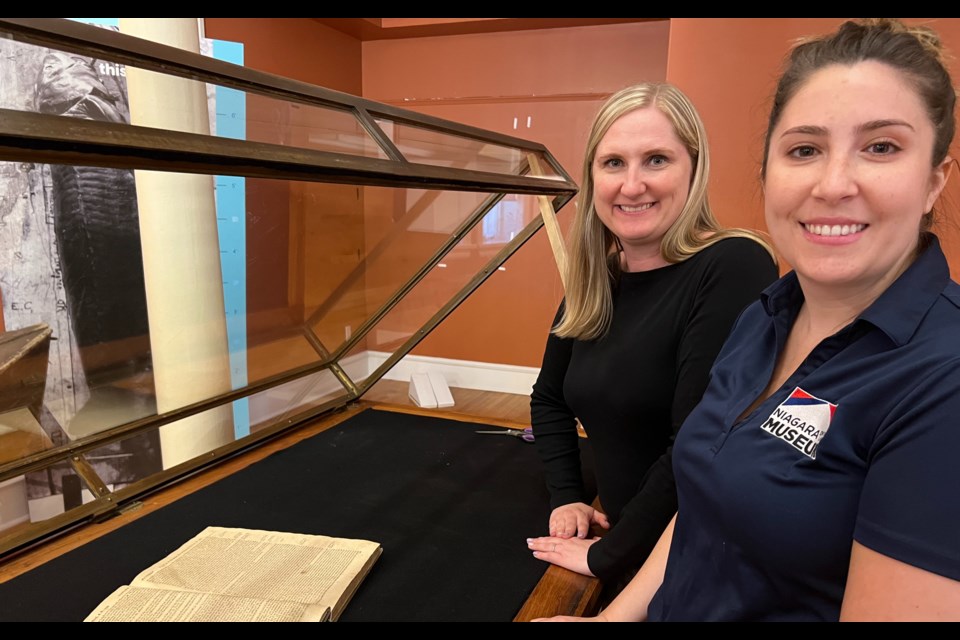Bound and Determined, the new exhibit at the Niagara-on-the-Lake Museum, honours Chloe Cooley, an enslaved woman whose resistance compelled Lieutenant Governor John Graves Simcoe to pass the Act to Limit Slavery in 1793.
“The museum is focusing on early Black history, and in particular, enslavement that existed in Niagara-on-the-Lake,” explained Sarah Kaufman, managing director and curator of the museum.
In February, Canada Post released a stamp paying tribute to Cooley, and posted a video explaining Cooley’s role in changing the course of Canadian history, with input from Kaufman, appears in the video, found on YouTube.
“After the American Revolution, the prevalence of enslavement in Canada grew, which fuelled the abolitionist movement,” said the narrator. “Hearing rumours that enslavement could be banned, some decided to sell what was legally considered their property, while they could.”
On March 14, 1793, in Queenston, Upper Canada, Cooley was “bound and forcibly taken across the Niagara river and sold off into the United States slavery system” by her enslaver, Adam Vrooman, said Kaufman. Cooley resisted, but did not escape. What became of her is unknown.
Witnesses to her abduction provided testimony to Simcoe, who opposed slavery, and on July 9, 1793, he passed the Act to Limit Slavery, which included banning the importation of enslaved people to Upper Canada and ruled that the children of enslaved women would be freed when they turned 25.
The Act also created a legal refuge for those fleeing enslavement in other countries. This paved the way for at least 30,000 freedom seekers to make the dangerous journey north to Canada.
“This is the 230th anniversary of the Act to Limit Slavery and the Chloe Cooley incident,” said Kaufman. “There was slavery here in Niagara,” she emphasized.
“On display will be a rowboat which is very similar to the one that Chloe might have been bound in and brought across the river.”
An enlarged version of the stamp from Canada Post will be displayed, as well as information about the “development of the coloured village here in Niagara-on-the-Lake, which was south of John Street,” said Kaufman. “We will have a map in the new exhibit to show where it was, and we’ve adapted it from the book Slavery and Freedom in Niagara that a local, Nancy Butler, actually worked on with Michael Power. They identified a lot of the homes and properties that were either owned or rented by black residents.”
While not many artifacts relating to enslavement are in existence, Kaufman has borrowed items from the St. Catharines Museum, Ontario Heritage Trust and the Archives of Ontario, which has lent the museum “the original Act that Simcoe and the legislative assembly put forth on July 9, 1793,” said assistant curator and education programmer Shawna Butts.
The exhibit will also display “items that relate to the families here that existed, a few pieces that represent punishment tools, plus a few pieces from our collection,” said Kaufman.
“We plan to unveil an original art piece for our Bound and Determined Exhibition on July 9, the anniversary of the passing of the anti-slavery legislation,” said Kaufman, explaining the museum is partnering with Natasha Henry-Dixon, along with Rochelle Bush, a trustee at the Salem Chapel which is the Harriet Tubman church in St. Catharines. “It’s a really great community partnership with museum staff and individuals who are very well-versed in that early history.”
Bound and Determined opens June 2 with a $5 admission charge for adults. “June 4 is our Janet Carnochan day and admission is free on June 4,” said Kaufman. Carnochan was president of the Niagara Historical Society in the early 1900s and was largely responsible for the opening of Memorial Hall, Ontario’s first purpose-built museum, and one of three linked buildings of today’s museum. The exhibit closes Nov. 14.
“There is a commonly held belief in Canada that we are the ‘freedom land,’” said Kaufman. However, “slavery did exist here and Chloe Cooley is who we really want to highlight, a former slave, what her fight against enslavement meant for the changes in legislation here for the anti-slavery act, and how that affected the Black community here in Niagara.”



